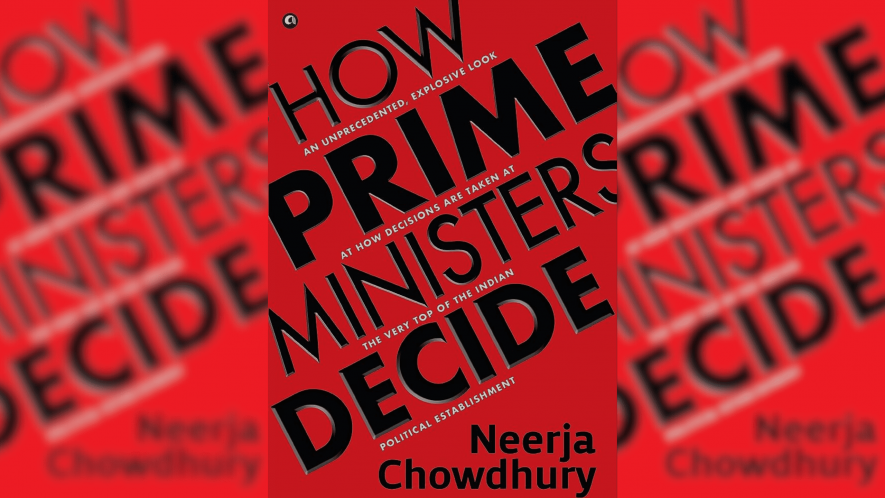How Some of India’s Prime Ministers Took Decisions

Image courtesy Aleph Book Company, 2023
Journalist Neerja Chowdhury, who has reported on Indian politics for nearly half a century, describes in her first book, How Prime Ministers Decide, published by Aleph Book Company, the crucial decisions six prime ministers took during their terms in power and the factors—including individuals and outfits like the RSS—that influenced some of their choices. From Rajiv Gandhi’s undoing of the Shah Bano verdict and VP Singh, deciding during his short stint in power to implement the Mandal Commission report, Chowdhury’s accounts, based on historical sources and personal encounters, present a rich cast of characters from across the political spectrum.
Beginning from Indira Gandhi’s tenure as prime minister in the 1970s and ending with the Bharatiya Janata Party-led coalition that came to power in 2014, the book shows how prime ministers, presented with unique challenges, shaped Indian society and politics for better or worse.
The following are excerpts from the book.
Where does Modi stand out as different from his predecessors? At the time of writing, he is already the longest serving non-Congress prime minister, having completed more than nine years in office, and holding his own in the popularity charts—which can be said about few world leaders today.
Rajiv Gandhi was also known to be tech-savvy, his rise coinciding with the age of the personal computer. But more than any other PM, Modi has effectively used social media, free data, the latest technology and communication tools, and the best that was available to him from around the world by way of PR companies and lobbyists to cultify his leadership and magnify his message. He knows the value of optics today, the need to be messaging 24 by 7 by 365.
His style is to do big and dramatic things—and to spring a surprise. If there is one word that sums up this style, it is ‘bhavya’ (grand). Once an official had asked him how he wanted a particular building to be done. ‘Whatever you do,’ he told the official, ‘it has to be bhavya.’ He has chafed against what he called a ‘kalpanik daridrata (lack of imagination to do big things)’ in the country.
This penchant for the big and the bold reflects in his vision of national iconography, as well. So, the new Parliament and the Central Vista had to signify an end to the country’s colonial past, and identify him with the new structure. Sardar Vallabhbhai Patel’s statue had to be the tallest in the world, the Madison Square Garden meeting in New York for the Indian diaspora had to be the grandest such event ever held. Black money had to be eliminated by a fiat delivered on national TV at 8 p.m.
Nehru took the Congress Party to victory in national elections in 1952, 1957, 1962. Indira Gandhi also won three elections, in 1967, 1971, and 1980—but lost in 1977. Vajpayee took his party to victory in three Lok Sabha elections in 1996, 1998 and 1999, but in none of those general elections did the BJP get a majority on its own. However, Vajpayee won as many as ten Lok Sabha elections individually—no small record.
Modi has never lost an election he contested. And he only fought his first election as late as 2002—after he became the chief minister of Gujarat.
In fact, there is no other prime minister who has won as many elections for his party as has Narendra Modi. He contested five elections and took his party to victory in all—three of them in Gujarat, in 2002, 2007, and 2012, and two national wins, in 2014 and 2019, when he became prime minister. The sixth election he contested was a by-poll which he won in early 2002 to get into the Gujarat state assembly to remain as chief minister. He has been the main vote-getter for the BJP in virtually every state election held since 2014.
RSS–BJP ideologue K. N. Govindacharya used to say about Modi’s electoral successes, ‘Narendra’s forte is political marketing….’ Politics is equal to power. Power stems from elections. Elections are a battle of images. And therefore politics revolves around images, messages and signalling.’
[…]
I want to end this narrative with a story about Jawaharlal Nehru and Sardar Vallabhbhai Patel—the iconic, but controversial, first ‘jodi’ of independent India because it illustrates what leadership is all about. They belong to an age gone by, but have relevance for today’s India. They could not have been more different—Nehru, Left and liberal, and a man of ideas, Patel, Right and pragmatic, and a man of action.
It is well known that Jawaharlal Nehru was not the choice of the Congress Party to become the Congress president in April 1946. Nehru was the choice of Mahatma Gandhi. As Congress president, he became the prime minister (vice president of the executive council) in the interim government in September 1946—and again in 1947.
It was at Gandhi’s instance that Sardar Patel withdrew in Nehru’s favour, a decision that could not have been easy for the hero of the Quit India movement—and one that excites controversy many decades down the line. For Gandhi, Nehru and Patel were ‘two oxen yoked to the government cart’. ‘One will need the other,’ he felt, ‘and both will pull together.’
When the transfer of power took place on 15 August 1947, Patel agreed to work under Nehru as deputy prime minister and home minister. But within five months of Independence, they lost Gandhi’s unifying presence to an assassin’s bullet on 30 January 1948. Just over an hour before Gandhi died, Patel was with Gandhi. They were having a heart-to-heart talk at Birla House in Delhi, and this is a story told by Rajmohan Gandhi in his biography on Patel. The Sardar spoke. Bapu listened, as he spun the charkha. He then ate his evening meal, and continued to listen to an agitated Patel. In the end, Gandhi told Patel calmly that his presence in the cabinet—and that of Nehru—was ‘indispensable’. Any breach between the two would be disastrous for the country. They decided to meet with Nehru the next day. Bapu, late for his 5 p.m. meeting, walked out on to the lawns where the prayers were to be held. Patel headed home. Within minutes, Patel and his daughter Maniben were back at Birla House. They were told that Bapu had been shot dead.
Nehru arrived a couple of minutes after Vallabhbhai. He went down on his knees, put his head next to Gandhi’s, and cried like a child. ‘Then he put his grieving head in the Sardar’s lap.’ India’s last viceroy, Lord Mountbatten, recalled what Gandhi had told him—that his dearest wish was to bring about a full reconciliation between Nehru and Patel. Both men embraced each other. That night, on 30 January 1948, they addressed the nation together, Nehru in English and Hindi and Patel in Hindi.
Three days later, on 3 February 1948, The Statesman published an article seeking Home Minister Patel’s resignation for his inability to protect Gandhi. Jayaprakash Narayan and other socialists led the attack on Patel. Patel wrote out his resignation letter to the prime minister. However, the letter was not sent. Patel’s private secretary, Vidya Shankar, persuaded him to hold it back—as he would be depriving the country of the joint leadership (by Nehru and Patel) that was Gandhi’s wish.
As it happened, Nehru also wrote to Patel the same day. ‘With Bapu’s death, everything is changed and we have to face a different and more difficult world….I think it is my duty and, if I may venture to say, yours also for us to face it together as friends and colleagues. Not merely superficially but in full loyalty to one another… I can assure you that you will have that from me.’
On 4 February, for the first time, Sardar Patel called Nehru, ‘my leader’.
‘I am deeply touched,’ Patel wrote to Nehru the next day, ‘we both have been lifelong comrades in a common cause. I had the good fortune to have a last talk with Bapu. His opinion also binds us both and I can assure you that I am fully resolved to approach my responsibilities…in this spirit.’
The new government headed by Nehru and Patel had to oversee one of the largest migrations in human history that displaced 15 million people on the subcontinent. It had to rehabilitate millions of refugees who had come over from Pakistan—and to craft a Constitution based on adult franchise and liberal principles. It had to politically integrate what was British India and the 565 princely states, headed by rulers, used to enforcing their writ, to become a sovereign, independent nation—which was ably done by Sardar Patel, the Iron Man of India. Together they had to stabilize the new country. The British had not handed India a readymade nation.
It is not as if Patel allowed Nehru to get his way always in the months that followed. In the three years after Independence, and till he died in 1950, Patel had his way in many decisions, like the appointment of Rajendra Prasad, a devout Hindu, as India’s first president instead of C. Rajagopalachari, whom Nehru wanted. He also got his nominee Purushottam Das Tandon elected as Congress president in 1950 instead of J. B. Kripalani, who was backed by Nehru.
When Patel was canvassing for support for Tandon, and asked Assam minister Fakhruddin Ali Ahmed, later to become president of India, to back him, Fakhruddin replied he would do only ‘as Panditji wants’. Patel shot back, ‘Fakhruddin, do exactly what you like. But remember Jawaharlal can never help a friend nor ever harm an enemy. I never forget a friend and never forgive an enemy.’
Nehru and Patel differed on many issues—as on their assessment of an organization like the RSS. Nehru believed it was a fascist organization. Patel saw it as courageous but misguided, and banned it for a year and half after Gandhi’s assassination.
Patel passed away in December 1950. After his death, Nehru consolidated his hold on both the government and the party. Nehru and Patel were not flawless men. By accepting to be number two, Patel made the greater sacrifice of the two. It must have also been difficult for Nehru to submit to Patel whenever he was outmanoeuvred by his deputy. But they displayed sagacity—and restraint—in those early years of Independence. They held together, despite deep differences, to hold together the new entity called India which had been given in their custody.
Gandhi had known—and Nehru and Patel knew—that they would need to move in step to steer a vast, vibrant, and diverse nation like India, with ethnic, religious, caste, and linguistic differences of a kind that did not exist anywhere else in the world—a challenge that remains as formidable today as it was in their time.
Personifying India’s plural ethos, Nehru and Patel showed that it was possible for two divergent strands of thinking to coexist and collaborate for a national cause. They discovered that power is most secure when it is shared, especially with those who act as a sounding board rather than an echo chamber. It is a lesson that India, and its leadership, should not forget.
This is an excerpt from How Prime Ministers Decide by Neerja Chowdhury, published by Aleph Book Company. Republished with permission.
Neerja Chowdhury is an award-winning journalist and political commentator. This is her first book.
Get the latest reports & analysis with people's perspective on Protests, movements & deep analytical videos, discussions of the current affairs in your Telegram app. Subscribe to NewsClick's Telegram channel & get Real-Time updates on stories, as they get published on our website.
























